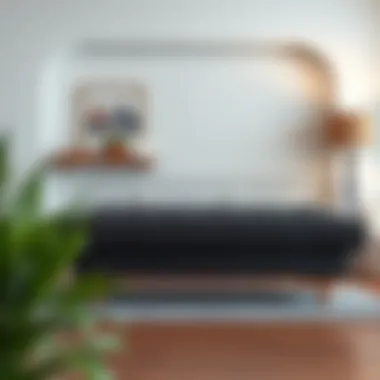Exploring Faux Leather Futon Covers for Your Home


Intro
Faux leather futon covers are often overlooked when it comes to furnishing a home. In recent years, however, they have gained popularity for their unique blend of style, functionality, and affordability. Understanding the ins and outs of these covers can help homeowners and designers alike make informed decisions to elevate their living spaces.
In this comprehensive guide, we will navigate through various aspects of faux leather futon covers. From their design styles to practical care tips, each component is essential for harmonizing aesthetics with day-to-day utility. With a keen focus on materials, durability, and current design trends, we aim to provide a well-rounded perspective for anyone interested in enhancing their décor with these versatile items.
Furniture Design Styles
Overview of Popular Styles
Faux leather futon covers come in a variety of design styles, catering to the diverse tastes of homeowners and designers.
- Modern Minimalist: Clean lines and neutral tones define this style. Faux leather in black or white works well in contemporary settings, providing a sleek and uncluttered look.
- Industrial Chic: This aesthetic embraces a rugged feel, making colors like dark grey and bronze suitable choices. Pairing faux leather with metal accents can create a striking contrast that’s both stylish and functional.
- Vintage Retro: Earthy tones and rich textures are characteristic of this style. A deep brown or olive green faux leather cover can lend a nostalgic vibe, particularly when matched with vintage furnishings.
How to Mix and Match Styles
Mixing styles is where creativity really comes into play. Faux leather covers can seamlessly integrate into various design themes. Here are some tips to consider:
- Balance Textures: Pairing faux leather with fabrics such as cotton or linen can soften the visual impact while adding warmth.
- Color Cohesion: Select covers in complementary shades to tie different styles together. A muted charcoal cover can bring a unified look even in an eclectic setting.
- Layering: Incorporate cushions or throws in different materials to create an inviting atmosphere, drawing the eye back to the futon cover itself.
Mixing and matching styles allows for personal expression, creating a space that feels uniquely yours.
Practical Tips for Homeowners
Essential Buying Tips
When selecting a faux leather futon cover, it's important to consider a few factors:
- Material Quality: Look for high-quality faux leather that is durable and resistant to wear. Check for features like soft-touch finishes and waterproof options.
- Size Compatibility: Ensure the cover fits snugly on your futon. Measure your futon dimensions accurately and refer to product specifications.
- Color Choice: Choose colors that match or complement your overall home décor. Light colors can brighten a room, whereas darker shades add sophistication.
Maintenance and Care Guidelines
Caring for faux leather is relatively straightforward, but it does require some attention:
- Cleaning: Use a damp cloth with mild soap to wipe off stains. Avoid harsh chemicals that could damage the material.
- Storage: If not in use, keep covers out of direct sunlight to prevent fading and damage. Rolling the cover can help save space.
- Avoid Overloading: Be mindful of how much weight you are putting on the futon to maintain the cover’s integrity over time.
Staying on top of these care tips can ensure that your faux leather futon covers remain a stylish part of your home for years to come.
In summary, understanding the interplay between style, practicality, and maintenance enables homeowners, designers, and furniture enthusiasts to better integrate faux leather futon covers into their living spaces. Whether opting for a modern minimalist look or an industrial chic vibe, the right choice of futon cover can make all the difference in achieving that perfect balance between aesthetic appeal and day-to-day functionality.
Preface to Faux Leather Futon Covers
In today's home decor landscape, faux leather futon covers have emerged as a significant player, marrying style with practicality. This article will dive into the nitty-gritty of faux leather futon covers, elucidating their advantages, design potential, and upkeep needs. Whether you’re a seasoned interior designer or a homeowner keen on giving your space a fresh look, there’s a wealth of information to uncover.
Faux leather is often seen as a cost-effective alternative to genuine leather, yet it offers a unique set of characteristics that can elevate any room. For example, not only are these covers available in a plethora of styles and colors, but they also provide a touch of sophistication without the hefty price tag.
When we speak of faux leather, we refer to materials made from synthetic fibers designed to mimic the appearance and texture of natural leather. This aspect is increasingly appealing to environmentally conscious consumers who appreciate ethical considerations in regards to animal welfare. Faux leather futon covers don’t just dress up your furniture; they present a lifestyle choice that aligns with a growing desire for responsible consumerism.
However, it’s not all about looks. Understanding how these covers function—including how they stand up to wear and tear—is crucial for making an informed purchase. Many buyers desire not only aesthetic charm but also durability and ease of cleaning. This section lays the foundation for the subsequent parts of the article, guiding readers through the qualities they should look for, the trends influencing their design, and the practical considerations that come into play when opting for faux leather covers.
The infusion of faux leather into interior spaces mirrors broader changes in design preferences, showing a shift toward materials that blend beauty and functionality. As we navigate the following topics, we will explore the intricate balance between style, utility, and ethical implications that defines faux leather futon covers.
"Choosing the right futon cover can transform a space, blending comfort with elegance while reflecting personal values."
Standby for insights that will guide you not only in selecting the right faux leather futon cover but also in understanding how to care for it and seamlessly integrate it with your existing home decor.
Understanding Faux Leather: Material Composition
Understanding faux leather is crucial when considering futon covers, as its composition can directly impact durability, aesthetics, and maintenance. Faux leather, often lauded for its versatility and affordability, is primarily made of synthetic materials designed to mimic the luxurious appearance and feel of real leather. This section explores two essential aspects of faux leather: the differences between synthetic and real leather, and the variations in faux leather quality.
Synthetic vs. Real Leather
When we talk about synthetic leather, it creates a perfect illusion of its natural counterpart. Often made from polyvinyl chloride (PVC) or polyurethane (PU), these materials offer a variety of textures and finishes that can rival real leather in appearance. A significant perk of synthetic leather is its resistance to stains and spills, making it a popular choice for busy households.
However, real leather carries a certain prestige that synthetic substitutes often fall short of replicating. Its natural grain and aromas can add a unique character to furniture; not to mention the durability and longevity you get from genuine hides, which can withstand years of wear and tear if cared for properly.
"While faux leather appeals to the budget-conscious, genuine leather is an investment in longevity and timeless style."
But here’s the kicker: choosing between the two often boils down to personal preference and lifestyle. For instance, if you have pets or young kids, a durable faux leather might be more practical than a fine leather that requires meticulous care. Understanding these differences shapes informed choices.
Variations in Faux Leather Quality
Quality in faux leather varies widely, influenced by the manufacturing processes and the materials used. Some covers are simply coated, while higher-end options might include multiple layers that enhance durability and texture. Here’s what to look for:
- Thickness: Thicker faux leather often means better durability. Thinner options may be more prone to tearing and wear.
- Finish: Some finishes imitate the luxurious look of suede or even glossy leather. Higher quality faux leathers often have more complex textures that add depth.
- Breathability: A good faux leather will allow air to circulate to prevent discomfort during long periods of use. This can be particularly important for covers that are used daily.
When shopping, it’s wise to touch and feel the materials rather than relying solely on online images, as visual representation may not capture how it really feels or wears over time.
Benefits of Using Faux Leather Futon Covers
Faux leather futon covers have carved out a remarkable niche within interior design and home décor, particularly for those looking to combine style and practicality. Understanding the benefits of these covers is essential for anyone wanting to elevate their space without breaking the bank or sacrificing comfort. Here, we'll dive into three important aspects: cost-effectiveness, versatile aesthetic appeal, and ease of maintenance.
Cost-Effectiveness
One of the main draws of faux leather futon covers is their affordability compared to genuine leather options. Many homeowners understand the pinch of budgeting, and faux leather fits right into a wallet-friendly category without compromising on style. These covers offer an attractive alternative for those who admire the luxurious look of leather but can't justify the often-breathtaking price tag.
- Affordability: Purchase price is significantly lower, making it easier for consumers to update their furniture frequently.
- Durability: Despite the lower cost, many faux leather covers are designed to withstand the wear and tear typically associated with active living spaces.
- Value for Money: Investing in a faux leather cover means you’re not sacrificing quality. Look for options that come with warranties or satisfaction guarantees for added peace of mind.
"Faux leather covers allow your creative juices to flow without burning a hole in your pocket."


Choosing a faux leather cover means that style isn't limited to those with deep pockets. Instead, it's accessible to a wider array of homeowners, DIYers, and decorators looking for bargain finds.
Versatile Aesthetic Appeal
In an era where personal expression through design is paramount, faux leather futon covers shine brightly. They come in an array of colors, patterns, and finishes, allowing them to fit seamlessly into nearly any design scheme.
- Color Variety: From classic blacks and browns to vibrant hues and even pastels, you’ll find options that match or contrast any existing décor.
- Patterns and Textures: Faux leather can mimic the grain of real leather or be presented in unique, artistic patterns, giving homeowners the opportunity to explore their aesthetics freely.
- Seasonal Switching: The affordability of these covers means that it is feasible for designers or homeowners to change their covers with the seasons or trends, ensuring that their spaces feel fresh and current throughout the year.
This versatility makes faux leather covers a smart choice for anyone looking to keep their living space dynamic and visually appealing.
Ease of Maintenance
Unlike genuine leather, which often requires specialized cleaning and conditioning products, faux leather offers a level of low maintenance that is appealing to busy households.
- Simple Cleaning: Often, a damp cloth will do the trick when it comes to cleaning faux leather. This simplicity can be a significant relief for parents or pet owners who fear stains or destruction.
- Stain Resistance: Many faux leather products come treated with finish that repels spills and stains, making them more forgiving in an active setting.
- Longevity: With proper care, faux leather can serve well beyond just a few years. Unlike natural materials, it doesn’t easily absorb moisture or odors, maintaining a fresher appearance longer.
Each of these traits adds up, signifying that making a choice toward faux leather futon covers isn’t just a trendy decision; it is a practical one as well. In summary, when you weigh cost-effectiveness, aesthetic versatility, and ease of maintenance together, faux leather futon covers emerge as a smart investment for enhancing your living space.
Design Options and Styles
Design options and styles hold a pivotal role in the conversation surrounding faux leather futon covers. They are not merely an addition to your interior; they can completely transform the atmosphere of a living space. Selecting the right design is crucial, as it intertwines with both aesthetic preferences and functional requirements. When homeowners and designers approach the task of choosing a futon cover, they must consider various elements like color, pattern, texture, and overall finish. This not only allows for personal expression but also must align with the room’s existing decor and intended vibe.
Color Choices and Patterns
Color choices can either make or break the look of any living area. Faux leather futon covers come in a plethora of colors, allowing for dynamic options to suit diverse tastes. For instance, a classic black or deep brown cover provides a timeless elegance, while more adventurous hues like teal or burnt orange can add playful pops to modern designs.
Patterns can heighten the uniqueness of a faux leather cover. Depending on personal taste, you might find geometric shapes invigorating or floral designs more comforting. Some manufacturers even provide customizable options where you can pick the colors and patterns that resonate with your style.
- Solid Colors: Offer a minimalist approach, versatile across settings.
- Patterns: Can add depth; choosing stripes or polka dots creates visual interest.
- Contrast: A light cover can stand out against dark furniture, creating a bold focal point.
When considering patterns, awareness of the scale is essential. Large motifs on a small futon cover can overwhelm the eye, whereas smaller patterns can add subtle enrichment without being overpowering.
Texture and Finish Variations
Texture is one of those aspects that might be overlooked, yet it holds significant weight in the design. Faux leather can mimic several finishes, such as matte, glossy, or pebbled. Each finish speaks differently to the room’s overall aesthetic.
- Matte Finishes: Offer a contemporary and understated appearance, suitable for relaxed environments.
- Glossy Finishes: Provide a high-end look that can brighten a space and reflect light, which can be especially useful in darker rooms.
- Pebbled Textures: Not only add tactile interest but are also practical, as they can help disguise wear and tear.
Finish variations can also influence how a futon cover feels to the touch. A soft, buttery finish can invite comfort, whereas a firm, structured look might resonate better in a minimalist decor scheme.
Choosing the right texture generally involves thinking about both how it correlates with your furniture and how it will perform in daily use. You wouldn’t want a slick finish in a house with children or pets, for example, where durability and ease of cleaning take precedence.
Remember: It’s the combination of colors, patterns, and textures that will truly elevate your space. Choosing wisely can bring harmony while expressing your unique style.
How to Choose the Right Faux Leather Futon Cover
Selecting a faux leather futon cover requires some thought as it significantly impacts both the aesthetics and functionality of your living space. A good cover doesn't just make your furniture look sharp; it also protects it from wear and tear, contributing to the overall longevity of your investment. Getting it right means you’ll be able to enjoy both style and practicality, making your space friendly and inviting.
Measuring Your Futon
One of the first steps in choosing the right faux leather futon cover is to measure your futon accurately. This seems straightforward, but many tend to take hasty measurements and ultimately end up with a cover that doesn’t fit quite right.
Start by measuring the length, width, and height of your futon. Keep in mind that futons often come in various sizes, so ensuring you have the exact dimensions is crucial. Here’s how you can do it:
- Length: Measure from one end of the futon to the other, from the furthest point.
- Width: Measure perpendicular to the length. Get this number right, as it will impact how the cover wraps your futon.
- Height: This should be measured from the ground to the top of the cushion. This dimension is especially important if your futon has a particularly thick cushion.
Once you have these dimensions, it’s wise to double-check before making any purchase. This will save you both time and potential frustration.
Aligning with Decor Themes
Picking a faux leather futon cover isn't just about functionality; it’s also about making sure it fits seamlessly into your existing decor. Take a moment to consider your room’s theme and color palette. Are you going for a contemporary look with sharp lines and geometric patterns, or does your space lean towards a rustic charm? This decision can guide your choice of cover color, texture, and overall design.
Ask yourself these questions:
- What colors are predominant in the room? Choose a cover that complements or contrasts harmoniously.
- Are there specific textures you want to incorporate? A matte finish might soothe a modern setting, while a more brushed or shiny finish could add depth and warmth to a cozy environment.
- What about patterns? Stripes or florals can introduce a playful element, but make sure they don’t clash with other elements in the room.
> The goal is to create a cohesive look that brings the whole room together.
Taking the time to align your futon cover with your decor theme can elevate your space and make it more inviting.
Ultimately, the right faux leather futon cover not only protects your furniture but also enhances your living environment, bringing together style and substance. To stay updated with the latest trends and ideas, consider browsing resources like Pinterest and Houzz where you can find visual inspirations tailored to your unique taste.
Installation and Fitting
When it comes to faux leather futon covers, proper installation and fitting are crucial for both aesthetic appeal and practicality. A well-fitted cover enhances the look of the futon, ensuring that it doesn't look like an afterthought. Proper installation not only prolongs the life of the cover but also contributes to comfort and convenience. The wrong fit can lead to sagging or bunching, making the futon less visually appealing and potentially damaging the fabric over time.
The significance of this topic cannot be overstated. Achieving the right fit ensures that the futon cover hugs the cushion snugly, which is not just important from a design standpoint, but also affects functionality. A loose cover can slide around, require frequent adjustments, and might even become a tripping hazard. Likewise, a cover that is too tight could rip or wear prematurely due to stress.
Tips for Proper Fit
- Measure Before You Buy: Always measure your futon before purchasing a cover. Clearly determine the length, width, and thickness. Remember that different manufacturers may have slightly different sizing standards, so pay attention to product descriptions and customer reviews.
- Select the Right Style: Various styles of faux leather covers might fit differently based on how they are constructed. For instance, if you're opting for a fitted style versus a looser draped cover, factor that in during your purchasing process.
- Utilize Elastic Edges: Covers with elastic edges can offer a better fit, as they are designed to stay in place. This little detail can make a big difference in keeping the cover securely on the futon.
- Adjust As Needed: After installing your futon cover, take some time to adjust it as necessary. Smooth out any wrinkles and ensure that it lays flat against the cushions for a polished look.
Ensuring a snug fit is like putting on a well-tailored suit—it instantly elevates the overall appearance.
Common Installation Mistakes to Avoid
While installing faux leather futon covers might seem straightforward, there are several pitfalls to look out for:
- Skipping Measurements: Some might think they can guess the size of their futon, but this often leads to frustration down the line. Accurate measurements make all the difference.
- Overstretching the Material: Faux leather can be delicate. Yanking the cover aggressively can lead to rips or tears. It's imperative to handle the material gently during the installation process.
- Neglecting To Read Instructions: Many covers come with specific instructions that detail how to properly fit them. Ignoring these can result in a poor installation. Always give instructions a once-over before diving into the fit.
- Ignoring User Reviews: Insights from previous buyers can shed light on how well a cover fits different futon types. If multiple users mention sizing issues, it's probably worth considering a different brand.
Ultimately, taking the time to install your faux leather futon cover correctly is well worth the effort. Not only does it perfect the room's aesthetic, but it also contributes to the longevity of your investment.
Maintenance and Care for Faux Leather


Caring for faux leather futon covers is not merely an afterthought; it’s an essential part of ensuring their longevity and maintaining their appealing appearance. Treat these covers well, and they can stay looking sharp for years, matching your home’s decor without breaking the bank or your spirit. Faux leather is designed to mimic the look and feel of genuine leather but requires a thought-out maintenance strategy to avoid wear and tear that could tarnish its stylish vibe.
Cleaning Techniques
When it comes to cleaning faux leather, the rules differ somewhat from those you’d follow for real leather. While genuine leather thrives on oils, faux leather can become grimy and dull if not cleaned properly. Here are effective cleaning methods to keep your covers spick and span:
- Use a Damp Cloth: For everyday cleaning, a simple damp cloth can work wonders. Just wet a microfiber cloth with water (add a mild soap if needed), wring it out, and wipe away dust and dirt.
- Sudsy Water Mix: For tougher stains, mix warm water with a few drops of dish soap. Dampen a cloth with this solution and scrub the affected area gently.
- Avoid Scrubbing Pads: Resist the urge to use abrasive scrubbers on faux leather; they might ruin the finish and lead to colors wearing off.
- Spot Cleaning: For stains, address them immediately. Use a cloth dampened with warm soapy water and gently blot the area - do not rub! Rubbing can push the stain deeper, making it harder to remove.
- Deep Cleaning Solutions: Once in a while, a deeper clean with a specialized faux leather cleaner can refresh the material. Make sure to test any cleaner on a hidden spot before applying it all over, just to be safe.
It’s vital to avoid harsh chemicals and solvents. These can cause fading, cracking, or peeling. Stick with gentle, pH-balanced products to ensure the faux leather retains its luster.
Storage Solutions
Effective storage also plays a significant role in maintaining faux leather covers. If you won’t be using the futon for a while, how you store it can prevent damage:
- Keep it Dry: Store your covers in a dry environment to prevent mold and mildew, especially if the futon itself isn’t regularly used.
- Avoid Direct Sunlight: Long-term exposure to sun can fade colors and dry out faux leather. If possible, wrap the covers in a light, breathable fabric to protect them or store them in a dark place.
- Roll, Don’t Fold: If you’re putting the covers away, consider rolling them instead of folding. This approach helps minimize creases and can keep the material looking fresh.
- Use a Breathable Cover: A breathable storage cover can ensure adequate airflow, preventing any moisture build-up. Using a plastic cover is a big no-no, as that can trap humidity.
In summary, a focused maintenance plan, centered on gentle cleaning and mindful storage, goes a long way in preserving the functionality and aesthetic appeal of faux leather futon covers. They not only stand up to everyday life but can continue looking their best with just a little bit of attention.
Environmental Considerations
When discussing faux leather futon covers, it is essential to dive into environmental considerations. This aspect often gets sidelined, despite being incredibly significant for homeowners and designers today. As people increasingly prioritize sustainability, understanding the environmental implications of materials plays a pivotal role in making informed choices. Faux leather, primarily made from synthetic materials, uniquely sits at the crossroads between aesthetic appeal and ecological impact.
Sustainability of Faux Leather
In recent years, sustainability has surged to the forefront of consumer consciousness. Faux leather, particularly when compared to traditional leather, offers a more sustainable alternative under several conditions. Most faux leathers utilize polyurethane or polyvinyl chloride, commonly known as PVC. While these materials are less resource-intensive than animal husbandry, their production can still contribute significantly to pollution if not managed rightly.
Here are a few sustainability aspects to contemplate:
- Energy Consumption: The manufacturing process is energy-intensive, which can lead to increased carbon emissions if sourced unsustainably.
- Recycling Challenges: Unlike natural materials, synthetic options often struggle with recycling due to a lack of proper facilities.
- Longevity: Higher-quality faux leather can endure wear and tear, potentially offering a longer lifespan than its cheaper counterparts. Longevity means less frequent replacements, which is a win for both consumers and the environment.
The sustainability of faux leather directly hinges on the production practices in place. Brands dedicated to eco-friendly methods are more likely to produce synthetic leather that reduces environmental impact.
Ethics in Material Production
Next comes the ethics surrounding the production of faux leather. As an alternative to genuine leather, faux leather claims to provide a more ethical option. However, this statement warrants a closer look. Ethical considerations revolve around both human rights and animal welfare.
Consider these points:
- Labor Conditions: The production of synthetic materials can sometimes involve low-wage labor in developing countries. Unequal labor practices raise questions about the ethics of sourcing.
- Animal Welfare: While faux leather eliminates the need for animal skins, some materials may still incorporate harmful chemicals harmful to human and animal health during their production.
- Chemical Usage: The manufacturing process may utilize toxic substances, presenting risks not just to workers but also to the wider environment.
A more truthful approach to the ethics of faux leather involves scrutinizing manufacturers closely. Companies that provide transparency about their supply chain and production methods should get preference.
"Choosing materials that are both beautiful and responsible can significantly alter the impact of our choices on the world around us."
In summary, while faux leather futon covers present a modern, stylish option for homeowners, evaluating their sustainability and ethical implications can enhance responsible decision-making in home décor. Raw material choices and responsible production not only align with aesthetic desires but also reflect a lifestyle that values our planet and its inhabitants.
Current Trends in Faux Leather Furniture
Faux leather furniture has made significant strides over the years, reflecting not just changes in consumer taste, but also shifts in environmental consciousness and technological advancements. With the rise in demand for stylish yet sustainable options, faux leather futon covers are becoming a staple in both contemporary and traditional settings. They blend practicality with aesthetics, offering a solution that caters not only to decor but also to the ethics of consumption. Recent trends highlight how faux leather is not just a substitute for the real thing but has evolved into a design statement in its own right.
Popular Design Inspirations
Inspiration for faux leather designs often draws from various cultural and artistic movements. The current wave includes influences from minimalist Scandinavian designs and bold, rich colors found in mid-century modern aesthetics. Homeowners and designers are embracing hues like deep emerald green, terracotta, and even classic black or white, which can complement virtually any interior.
- Scandinavian Minimalism: Simple lines and functional shapes define this trend. Futon covers in soft, muted tones can provide a clean look that enhances light and space.
- Rustic Chic: Textured finishes that mimic the look of aged leather can blend beautifully in rustic settings, marrying comfort with earthiness.
- Bold Statements: Bright colors and graphic patterns are becoming more popular, reflecting a shift towards personalization in home decor. Think geometric shapes or loud florals!
This blending of styles provides homeowners with a palette of options that speak to modern tastes while keeping the room functional and comfortable.
Integration with Modern Decor
As faux leather continues to gain traction, its integration with modern decor has become seamless. The adaptability of faux leather futon covers enables them to enhance various interior styles—from urban lofts to cozy country homes.
For instance, in urban apartments where space and style are both at a premium, a faux leather futon can serve as a chic centerpiece. Its smart silhouettes can elevate a sleek environment while providing necessary seating. Likewise, in a more eclectic setting, a vibrant faux leather cover could become a conversation starter, making the futon an eye-catching fixture.
Transitions from one decor style to another are simple. A faux leather cover can easily be switched out when changing themes—which is particularly attractive for homeowners who enjoy redecorating frequently.
Here are key points to consider:
- Versatility: Easily fits with varying decor styles, lending itself to both casual and sophisticated looks.
- Contrast: Pairs well with natural materials. Think wood or stone to create an interesting dialogue between textures and colors.
- Easy Update: When trends shift, changing a futon cover can breathe new life into a space without extensive renovations.
"Faux leather is more than just a trend; it reflects changing attitudes towards style, ethics, and sustainability."
Comparing Faux Leather Covers with Other Materials
When it comes to choosing the right covering for futons, a deep dive into various materials is crucial. This section sheds light on how faux leather stacks up against other options—particularly fabric. Understanding these differences not only helps homeowners make informed choices but also clarifies how these materials harmonize with different living environments. Faux leather is often lauded for its practicality and stylistic versatility, but it’s prudent to consider how it compares to its contemporaries.
Faux Leather vs. Fabric Options
Faux leather offers distinct advantages over fabric when it comes to durability and maintenance. Let's take a closer look:
- Durability: Faux leather is more resilient to stains and spills than traditional fabric. A quick wipe usually does the trick, which can translate into a longer lifespan for the cover.
- Aesthetic Appeal: While fabric options may come in myriad prints and textures, faux leather conveys a certain sleekness. It usually gives a space a more contemporary feel without significant investment.
- Allergy Considerations: Faux leather doesn’t harbor dust mites and allergens like some fabrics can. This makes it an attractive option for individuals who suffer from allergies or have pets.
However, there's a flip side. Traditional fabrics often offer comfort in terms of warmth and breathability, making them preferable for those in cooler climates. Additionally, they can sometimes bring texture and depth to a room that faux leather might lack.
Durability Comparisons
When it comes to durability, faux leather truly shines in many respects. Let's analyze some factors that contribute to its lasting nature:
- Resistance to Wear and Tear: Faux leather stands up remarkably well against the daily wear and tear that furniture encounters. Unlike typical fabric, it does not fray or rip easily, maintaining its form with regular use.
- Water Resistance: Faux leather generally offers better water resistance. A sudden spill can be dealt with more promptly and effectively, reducing the chances of staining.
- Ease of Repair: If faux leather becomes scratched, there are often simple ways to cover up the blemishes. Some manufacturers even produce repair kits specifically designed for faux leather, making upkeep easier.


However, one must note the limits of faux leather's durability. Although it withstands certain conditions with grace, extended exposure to direct sunlight can lead to fading over time. In contrast, several quality fabrics are treated with UV-resistant coatings, enhancing their longevity in sunlit spaces.
Pricing Considerations
Understanding the pricing of faux leather futon covers is fundamental for anyone looking to refresh their living space without breaking the bank. This section breaks down the various elements impacting the costs associated with these covers, helping consumers make informed decisions. By analyzing market prices, understanding value for money, and weighing the benefits, readers can navigate their purchasing journey with more confidence and clarity.
Understanding Market Prices
When shopping for faux leather futon covers, prices can vary wildly. Factors influencing these prices include quality, brand reputation, and intricate design elements. For instance, you might find a simplistic cover priced as low as thirty dollars while premium options can soar into the hundreds. Hence, it's crucial to assess what you get for your dollar.
- Quality of Material: A higher price often reflects a more durable and visually appealing material. Look for faux leather that mimics real leather closely. Brands like IKEA or Wayfair, often provide options at different price points, allowing consumers to choose based on their budget.
- Design and Functionality: Unique designs or added features, like water resistance, can justify a more premium price tag. If you notice some covers featuring intricate stitching or vibrant colors, these details may increase the overall cost.
- Size and Fit: The larger the cover, the higher the price is likely to be. If you have a standard size futon, you might find decent options at an affordable rate, whereas custom-made sizes could push the price upward significantly.
Understanding market prices thus requires investigating beyond mere numbers—looking at what determines these prices provides insight into where your money is truly going.
Value for Money: Is it Worth It?
When considering faux leather futon covers, buyers should ponder whether the investment aligns with their expectations and needs. Value for money is not a mere sticker price; it's about evaluating the long-term benefits these covers provide.
- Durability and Life Span: Quality faux leather tends to be robust, resisting wear and tear longer than fabric counterparts. This means that while a cheaper option may save you a few bucks initially, you might find yourself replacing it in a year or two.
- Aesthetic Beauty: A well-chosen faux leather cover can elevate the entire look of your living space. If the goal is to impress guests or create a cozy atmosphere at home, investing in a cover that looks and feels premium pays off in how you feel about your space.
- Maintenance Costs: Faux leather covers are often easier to clean compared to fabric. A quick wipe down can address spills and dirt, saving you both time and money spent on cleaning supplies or professional services.
In essence, the question of whether faux leather covers are worth it often resolves to personal priorities. If long-lasting, stylish, and low maintenance are high on your list, then the cost is likely justified.
"Investing in quality faux leather futon covers not only enhances your decor but can also be a savvy financial choice in the long run."
Assessing pricing requires a well-rounded perspective. By thoroughly considering all factors discussed above, consumers can make practical choices that suit their style and budget.
Faux Leather Futon Covers in Different Settings
The aesthetics and practicality of faux leather futon covers play a pivotal role in diverse living environments. These covers are more than just functional items; they also significantly contribute to a room’s overall vibe and cohesiveness. One could say, they are the finishing touches that transform a simple space into a harmonious sanctuary. Whether you are setting up a cozy urban apartment or a rustic countryside home, understanding how faux leather can adapt to different settings is essential for homeowners and decorators alike.
Urban vs. Rural Aesthetics
In urban settings, where space is often at a premium, faux leather futon covers can offer a sleek and modern look. Their contemporary aesthetic aligns well with minimalist designs, adding an element of sophistication without overwhelming the senses. Bright colors and geometric patterns can offset the starkness of a city environment. For example, a bold red faux leather cover could become a striking centerpiece in an otherwise monochrome room.
Conversely, in rural locales, the charm often stems from warmth and comfort, focusing on muted tones and textures that echo nature's palette. Here, the idea is to create a cozy atmosphere, integrating covers that mimic rustic leather while still being easy to clean and maintain. A rich brown or tan faux leather could work beautifully against wooden furniture, providing a sense of cohesiveness with the natural surroundings.
"The secret of style is to do things that others avoid. Faux leather futon covers allow you to stand out while keeping it practical."
To adapt faux leather in various environments, here are some considerations:
- Color Scheme: Match the cover with wall colors and other upholstery.
- Texture Contrast: Balance faux leather with softer materials like linens or cotton.
- Durability Needs: In high-traffic areas, thicker covers may be more beneficial.
Fitting into Various Room Styles
Faux leather futon covers are incredibly versatile, easily blending into numerous design styles. For instance, in a modern industrial space, a dark gray faux leather cover complements the raw elements like exposed beams and concrete floors, creating an appealing contrast that captures the eye.
On the other hand, if one leans more towards an eclectic style, a multi-patterned faux leather cover can add a pop of creativity among vintage finds and colorful artworks. The key to achieving harmony lies in selecting a cover that reflects the personality of the occupants while still supporting the room's established theme.
Here’s how faux leather can fit into various designs:
- Minimalist Design: Choose sleek, monochromatic covers that promote simplicity.
- Traditional Decor: Opt for richly colored faux leather that evokes classic elegance.
- Bohemian Style: Select vibrant, textured covers that playfully mix with diverse prints.
By considering these aspects, designers and decorators can ensure that their use of faux leather covers enhances the environment rather than detracts from it. The goal is to maintain functionality while elevating the aesthetic appeal of the space.
Consumer Reviews and Feedback
In the world of faux leather futon covers, consumer reviews and feedback play a pivotal role in shaping purchasing decisions. These insights not only reflect the actual experiences of users but also serve as a guide for potential buyers. Understanding these reviews is essential as it highlights performance in real-world conditions, which might not always align with manufacturer claims.
When diving into consumer feedback, several elements come into play. Firstly, it offers insights into the durability of the covers. Many users share experiences on how well their faux leather holds up against daily wear and tear. Buyers often look for materials that resist tearing and discoloration, which are vital in a busy home.
Moreover, reviews frequently touch on ease of cleaning and maintenance. Faux leather is generally favored for its low maintenance requirements, but real user stories provide a clearer picture. Some futon covers might require specific cleaning methods that aren't intuitive at first glance.
Another crucial aspect often explored in reviews is the comfort level. Given that futons serve multiple purposes, from seating to sleeping, consumers will comment on whether the cover enhances or detracts from comfort. This can be particularly important for those using futons regularly.
Additionally, consumer opinions are valuable for understanding the aesthetic appeal of various styles and colors. Feedback on how a cover aligns or clashes with different home decors can be quite useful for prospective buyers.
In short, tapping into consumer reviews and feedback allows potential buyers to make informed decisions that reflect their needs and preferences. Users not only offer useful insights but also highlight common pitfalls to avoid, ultimately contributing to a well-rounded understanding of faux leather futon covers.
Insights from Users
Diving into reviews often reveals a treasure trove of insights. Many users might gush about the rich texture and appearance of their chosen covers. For example, a review might highlight how a specific shade of black faux leather nuances a room, providing a rich sense of elegance compared to traditional fabric covers.
Conversely, some accounts may reveal disappointment, especially if the cover doesn’t match the online imagery. Users often express that a color looks striking in photos but appears dull or washed out in their living spaces. Thus, examining user feedback assists potential buyers in setting realistic expectations about color fidelity.
Furthermore, insights from users often delve into the fit and size of the covers. Customers might share tips on how to measure accurately to avoid having to play a game of trial-and-error at home. A few reviews may even detail how they managed to tailor a loose cover for a snugger fit.
Common Concerns
While feedback can be overwhelmingly positive, it's important to note concerns raised by users as well. One prevalent issue relates to the price point. Some consumers express dissatisfaction with the perceived value of certain faux leather covers, particularly those that begin to show signs of wear after only a few months of use. Such concerns highlight the necessity for buyers to consider product longevity in relation to cost.
Another common concern often surfacing is about odor. Many faux leather materials emit a distinct smell upon unpacking, which can deter certain buyers. Reviews often advise airing out covers before using them in living spaces, a detail that may escape new consumers.
Additionally, some reviews point out stitching quality as a concern. Users might note instances of threads coming loose after minimal use, which raises doubts about manufacturing processes. Addressing such issues in products’ descriptions and reviews helps consumers avoid regrettable purchases.
Ultimately, being well-informed about what others have encountered can guide buyers towards successful investments in faux leather futon covers.
Finale and Final Thoughts
In this exploration of faux leather futon covers, we have unraveled various dimensions ranging from material understanding to design possibilities, maintenance, and environmental considerations. Faux leather is not merely a substitute for real leather; it's a compelling option that offers durability, style, and functionality—all at a more affordable price.
Key Elements to Consider:
- Aesthetic Versatility: These covers seamlessly merge with diverse decor styles, allowing homeowners to express individuality while enhancing space elegance. Whether in a mid-century modern home or a rustic setting, faux leather has the flexibility to adapt.
- Practical Benefits: From easy cleaning routines to resistance against wear and tear, faux leather covers are designed for busy lives. They stand up well against spills and scratches, making them an excellent fit for homes with children or pets.
- Trend Consciousness: As we discussed current trends, it’s clear that faux leather is at the forefront of modern design. How it's perceived has evolved, making it a key player in the eco-friendly movement due to its synthetic nature, avoiding the ethical implications associated with real leather.
It’s crucial to approach the selection of faux leather futon covers with careful consideration of individual lifestyle needs, budget constraints, and stylistic preferences.
As the market continues to develop, understanding the nuances of faux leather enables consumers, designers, and retailers alike to make informed decisions. Prioritizing quality over price may lead to greater satisfaction in both appearance and performance long-term. Thus, making a thorough evaluation will not just enhance your living environment but also reflect a thoughtful approach to purchasing and sustainability.















